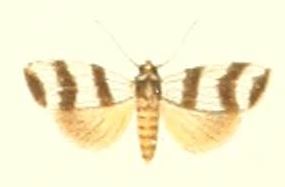
Cyana is a genus of moths in the family Erebidae. Species are well distributed in Africa, Madagascar, China, India, Sri Lanka, Myanmar, Sumatra, Java and Borneo. The genus was erected by Francis Walker in 1854.

Cyanopepla is a genus of moths in the subfamily Arctiinae. The genus was erected by James Brackenridge Clemens in 1861.

Eutane is a genus of moths in the subfamily Arctiinae. The genus was erected by Francis Walker in 1854.
Heliosia is a genus of moths in the family Erebidae erected by George Hampson in 1900.

The Aganainae are a small subfamily of moths in the family Erebidae. The adults and caterpillars of this subfamily are typically large and brightly colored, like the related tiger moths. Many of the caterpillars feed on poisonous host plants and acquire toxic cardenolides that make them unpleasant to predators. Like the closely related litter moths, the adults have long, upturned labial palps, and the caterpillars have fully or mostly developed prolegs on the abdomen. The Aganainae are distributed across the tropics and subtropics of the Old World.

Palaeosia is a monotypic moth genus in the family Erebidae erected by George Hampson in 1900. Its only species, Palaeosia bicosta, the two-ribbed arctiid or two-ribbed footman, was first described by Francis Walker in 1854. It is found in south-eastern Australia.
Bamra is a genus of moths of the family Noctuidae.

Asota is a genus of moths in the family Erebidae first described by Jacob Hübner in 1819. Species are widely distributed throughout Africa, India, Sri Lanka, Myanmar, the Malayan region and tropical parts of the Australian region.

Dysphania is a genus of colourful moths in the family Geometridae and typical of the tribe Dysphaniini; they are sometimes called 'false tiger moths' and are found in northeast Australia, Melanesia, and south, east and southeast Asia.
Cyanopepla jucunda is a moth of the subfamily Arctiinae. It was described by Francis Walker in 1854. It is found in the Brazilian states of Rio de Janeiro and Espírito Santo and in Argentina.
Eutane terminalis, the banded lichen moth, is a moth of the subfamily Arctiinae. It was described by Francis Walker in 1854. It is known from the Australian states of Queensland and New South Wales.
Heliosia aurantia is a moth of the family Erebidae. It was described by Rothschild in 1912. It is found in New Guinea.
Heliosia charopa is a moth of the family Erebidae. It was described by Alfred Jefferis Turner in 1904. It is found in Australia, where it has been recorded from Queensland.
Heliosia crocopera is a moth of the family Erebidae. It was described by George Hampson in 1900. It is found on New Guinea.
Heliosia micra is a moth of the family Erebidae. It was described by George Hampson in 1903. It is found in Australia.
Heliosia monosticta is a moth of the family Erebidae. It was described by George Hampson in 1900. It is found on Borneo. The habitat consists of lowland forests, dry heath forests and coastal scrubs.
Heliosia perichares is a moth of the family Erebidae. It was described by Alfred Jefferis Turner in 1944. It is found in Australia, where it has been recorded from Queensland and New South Wales.
Heliosia rufa is a moth of the family Erebidae. It was described by John Henry Leech in 1890. It is found in the Russian Far East (Primorye) and China.
Heliosia suffusus is a moth of the family Erebidae. It was described by Rothschild in 1913. It is found in New Guinea.




